Robots have been making their way into the operating rooms of hospitals and clinics all over the world. They can assist surgeons in performing complex procedures with precision and accuracy, and they can even carry out the surgery autonomously. As robots become increasingly integral to the medical field, the ethical implications of their use must be considered. In this article, we will explore the pros and cons of surgical automation, the importance of patient safety, and how to navigate the ethical considerations surrounding this technology.
Robotics: Revolutionizing Surgery
The introduction of robotics into the medical field has been met with both excitement and apprehension. On one hand, robots can offer a level of precision and accuracy that is hard to achieve with traditional surgical methods. They can also drastically reduce the time it takes to perform a procedure, meaning fewer complications and a faster recovery time for patients. Furthermore, robotic surgical instruments are able to work in tight spaces and can reach areas of the body that may be difficult to access with traditional techniques.
On the other hand, robots can be expensive to purchase and maintain. They can also be challenging to operate, requiring extensive training and expertise to get the most out of them. Moreover, robots have not yet been thoroughly tested in the field, so their safety and efficacy remain largely unknown.
Automation: Pros and Cons
Surgical automation has the potential to significantly reduce the risk of human error and increase the accuracy of procedures. Automated surgeries can be carried out with minimal human intervention, meaning patients are exposed to less risk and can recover faster.
However, the use of automation also brings with it some ethical concerns. For example, if a robot is carrying out a procedure autonomously, who is responsible if something goes wrong? Is it the surgeon who programmed the robot, or the manufacturer of the robot? Furthermore, robots do not possess the same level of empathy and understanding of a patient’s experience as a human doctor, so the decision-making process for a robotic procedure may be flawed.
Patient Safety: Key Concern
The most important consideration when it comes to surgical automation is patient safety. If a robot is used to carry out a procedure, it must be tested thoroughly to ensure that it is safe and effective. In addition, it is essential that surgeons and medical staff are adequately trained in the use of robotic surgical instruments.
Furthermore, hospitals and clinics should have protocols in place to monitor the performance of robotic surgical instruments. This can include regular maintenance and testing, as well as the monitoring of patient outcomes.
Balancing Benefits and Risks
Given the potential benefits and risks associated with surgical automation, it is important to weigh up the pros and cons carefully. The decision to use a robot for a procedure should not be taken lightly, and the potential risks should be fully assessed before a robot is used.
In cases where a robot is used, it is important to have a fail-safe system in place in case anything goes wrong. This could involve having a qualified surgeon on-site to take over the procedure if necessary.
Navigating Ethical Considerations
Given the potential ethical implications of surgical automation, it is important to carefully consider the implications of its use. For example, what are the consequences for the patient if something goes wrong? Do the benefits of using a robot outweigh the potential risks? How can we ensure that robots are not used in place of qualified medical professionals?
Furthermore, it is important to remember that robots can never replace the human element of surgery. They may be able to assist surgeons in carrying out complex procedures with precision and accuracy, but they cannot provide the same level of empathy and understanding as a human doctor.
Future Outlook for Automation
Robotics and automation are likely to play an increasingly important role in the medical field in the years to come. As technology advances, robots and automated systems will become more sophisticated and effective, and their use may become commonplace in hospitals and clinics. However, it is important to remember that robots are only a tool, and they cannot replace the human element of medicine.
The ethical implications of surgical automation must be carefully considered before robots are used in the medical field. The potential benefits must be balanced against the potential risks to ensure that patient safety is not compromised. With the right protocols and safeguards in place, robots could revolutionise the medical field and drastically improve patient outcomes.
In conclusion, the use of robotics and automation in the medical field presents a number of ethical considerations. However, with the right protocols and safeguards in place, robots could revolutionise the medical field and drastically improve patient outcomes.
